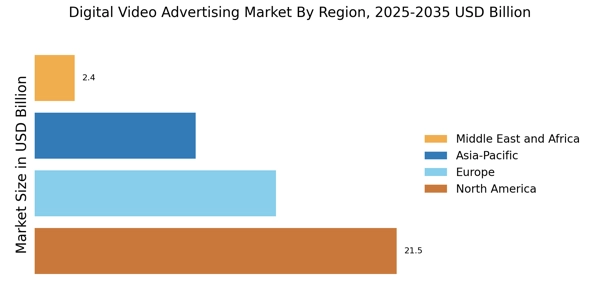Rising Mobile Device Usage
The proliferation of mobile devices has transformed the Digital Video Advertising Market. As of October 2025, mobile video consumption accounts for over 70% of total video views, indicating a shift in consumer behavior towards mobile platforms. Advertisers are increasingly targeting mobile users, leveraging the convenience and accessibility of smartphones and tablets. This trend suggests that brands must optimize their video content for mobile viewing to capture audience attention effectively. Furthermore, the rise of social media platforms, which are predominantly accessed via mobile devices, has created new avenues for video advertising. The integration of mobile-first strategies is likely to enhance engagement rates, thereby driving growth in the Digital Video Advertising Market.
Adoption of Advanced Analytics
The utilization of advanced analytics tools is reshaping the Digital Video Advertising Market. Advertisers are increasingly relying on data-driven insights to optimize their campaigns and measure effectiveness. As of October 2025, approximately 60% of marketers report using analytics to inform their video advertising strategies. This trend indicates a growing emphasis on understanding viewer behavior, preferences, and engagement metrics. By leveraging analytics, brands can tailor their content to resonate with target audiences, potentially increasing conversion rates. Moreover, the ability to track performance in real-time allows for agile adjustments to campaigns, enhancing overall effectiveness. The integration of analytics into video advertising strategies is likely to be a key driver of growth in the Digital Video Advertising Market.
Growing Demand for Video Content
The increasing demand for video content is a pivotal driver in the Digital Video Advertising Market. As of October 2025, video content is projected to represent over 80% of all consumer internet traffic. This surge in demand is prompting brands to invest heavily in video advertising to capture audience attention. The popularity of platforms such as YouTube, TikTok, and Instagram Reels has created a fertile ground for video ads, allowing brands to engage with consumers in innovative ways. Furthermore, the rise of short-form video content aligns with changing consumer preferences, suggesting that advertisers must adapt their strategies accordingly. This growing appetite for video content is likely to propel the Digital Video Advertising Market forward.
Shift Towards Programmatic Advertising
The shift towards programmatic advertising is significantly influencing the Digital Video Advertising Market. As of October 2025, programmatic ad spending is projected to account for over 80% of all digital video ad expenditures. This automated approach allows advertisers to purchase ad space in real-time, optimizing targeting and efficiency. The rise of programmatic advertising suggests that brands can reach specific demographics more effectively, enhancing the relevance of their video content. Additionally, programmatic platforms often provide detailed analytics, enabling advertisers to assess campaign performance and make data-driven decisions. This trend indicates a move towards more sophisticated advertising strategies, which could lead to increased investment in the Digital Video Advertising Market.
Emergence of Augmented Reality and Virtual Reality
The emergence of augmented reality (AR) and virtual reality (VR) technologies is poised to revolutionize the Digital Video Advertising Market. As of October 2025, the AR and VR market is expected to reach a valuation of several billion dollars, with a significant portion allocated to advertising. These immersive technologies offer unique opportunities for brands to create engaging and interactive video experiences. By integrating AR and VR into their advertising strategies, companies can enhance consumer engagement and create memorable brand interactions. This trend suggests that advertisers who embrace these technologies may gain a competitive edge in the Digital Video Advertising Market. The potential for AR and VR to transform traditional advertising formats indicates a shift towards more experiential marketing approaches.


















Leave a Comment